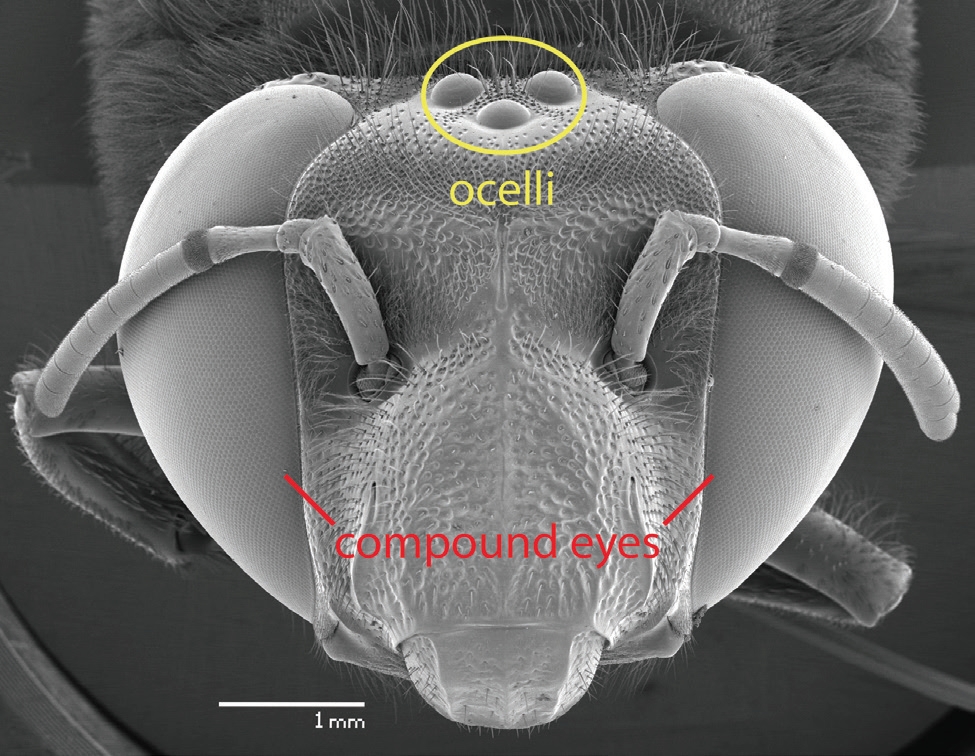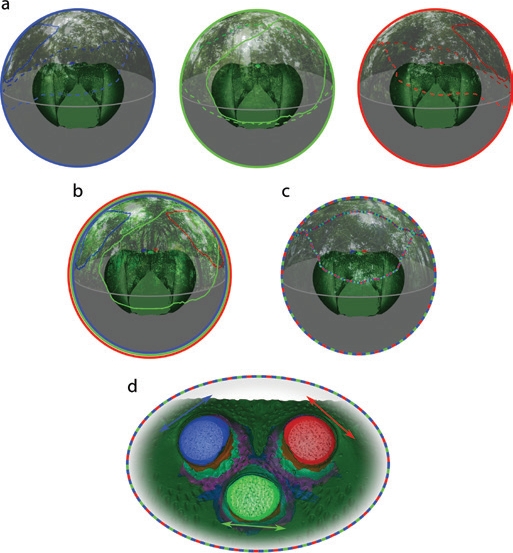Insects, such as bees, are cleverly equipped with miniature sensory organs that enable them to safely fly through cluttered environments like rainforests. They rely heavily on their vision, so to understand how they are capable of such complex navigation, it is important to characterise their eyes.
The longest beamline at Diamond Light Source, the Diamond Manchester Imaging Branchline (I13-2), was used to perform 3D scans of the eyes of bees in high resolution. The beamline has the capacity to enhance the contrast between tissues, permitting a detailed view of separate structures of the eyes. As well as looking at the structure of bee’s eyes, a technique called ‘ray tracing’ was performed which allowed the researchers to see how the eyes focussed beams of light to view their environment.
By using the I13-2 beamline, the first ever high resolution 3D model of a complete biological visual system was made possible. The model showed that the retinas of bees contain two distinct regions: one that focuses light over a small area, which is oriented towards the horizon, plus a second region that receives unfocussed light but is shared by three eyes to create a trinocular field of view. This imaging method can be applied to the eyes of a whole range of other species, not only insects, so it could potentially further our understanding of how animals see the world.

Figure 1: A scanning electron microscope image of the head of an orchid bee, Euglossa imperialis, showing the positon of the two large compound eyes and the three small ocelli.
Despite their diminutive size, orchid bees are capable of navigating over several kilometres between food sources and their nest through their densely cluttered rainforest habitat. This is a remarkable feat considering that they do this with nothing but their miniature brains and sensory systems. Even modern engineering techniques have failed to replicate the capabilities of these buzzing marvels of nature. Despite decades of research, how insects such as the orchid bee are capable of navigating safely through their world is still not understood. Previous studies have demonstrated that many flying insects rely on vision to do this, although the underlying mechanisms remain unclear. To begin to understand how insects such as orchid bees negotiate their complex rainforest habitat, it is therefore necessary to understand what visual information they are capable of seeing. The related publication aims to do this by generating 3D models of their eyes using a technique called X-ray Microcomputed Tomography at the I13-2 beamline.
Like many other flying insects, orchid bees possess five eyes, two large compound eyes and three smaller eyes called ocelli (Fig. 1). In other insects, ocelli have been shown to play a role in head and flight stabilisation by measuring the relative brightness of the visual scene at the horizon2. As the sky is generally brighter than the ground, insects can keep their head and body in the correct orientation for maintaining lift by keeping the bright part of the visual scene pointing upwards. It has been hypothesised that, to best support this function, these eyes should be unfocussed and should sample light from a wide field of view. Standard histological analyses using electron microscopy on thin sections of ocelli from different insect species have supported this hypothesis3. However, these analyses are limited because information about the orientation of the eyes on the head, and the full extent of the field of view is lost. To overcome these limitations, high-resolution 3D models of the ocellar structures, including the lenses and retinae, were generated using X-ray microtomography. From these models, it was possible to reconstruct not only each eye but also how they were oriented in the world when the bee was in flight.

A mathematical technique called ray-tracing was used to describe the field of view of each ocellus. This technique places the 3D model of the eye at the centre of a virtual sphere (Fig. 2a) and analyses whether rays of light emanating from different parts of the sphere would enter the lens. Combined with information about how the lens refracts the light that enters it, it is possible to calculate the region of space over which the retina would receive light – the extent of its field of view – as well as whether this light would be focussed or unfocussed (Fig. 2b). Several important discoveries about the ocelli were made from this analysis. The first is that they have very large fields of view that are generally oriented upwards, towards the sky. The second discovery is that, while much of the retina in each eye received unfocussed light, some small regions of each ocellus received focussed light. These focussed regions were oriented towards the horizon in each eye, suggesting that these regions may provide important information for head stabilisation during flight. The third, and most remarkable discovery was that the most upwards-looking region of each eye overlapped with those of the other eyes. This means that each eye looks at the same part of space, resulting in a never-before described trinocular (that is, three eyes looking at the same region of space) field of view.
To understand the function of the unusual trinocular field of view, electron microscopy was performed on sections through the ocellar retinae. The analysis showed that the photoreceptors (the light sensitive cells comprising the retina) were formed in such a way that they would be able to detect polarised light. Moreover, the orientation of the photoreceptors was different in each retina, suggesting that the trinocular region of each eye would be maximally sensitive to different angles of polarised light. This organisation would mean that, together, the three ocelli would be able to directly analyse the pattern of polarised light in the sky, enabling the bees to know the sun’s position, and to therefore use it as a compass reference, just by viewing a small patch of the sky. This ability would be critical for an animal that needs to navigate in the rainforest where the sun and much of the sky is often occluded by the canopy or clouds.
By using X-ray microtomography to build 3D models of the eyes of orchid bees, it was possible to describe their visual world and to reveal features that would not be found using conventional techniques. By having separate focussed regions oriented towards the horizon and a shared trinocular field of view oriented upwards, the ocelli of orchid bees appear to perform at least two distinct functions. This phenomenon is not necessarily unique to orchid bees but may represent a common adaptation to the challenges of navigating in a rainforest. Future investigations will focus on testing this idea by describing the ocelli of other tropical bees as well as describing the visual world they experience through their larger, more complex compound eyes.
References:
Funding acknowledgement:
Swedish Research Council (2014-44295-114711-25) US Air Force (FA8655-12-1-2136) Carl Tryggers Stiftelse (CTS14:38) The Royal Physiographic Society of Lund Diamond Light Source (proposal 10336)
Corresponding author:
Dr Emily Baird, Department of Biology Lund University, emily.baird (at) biol.lu.se
Related publication:
Taylor GJ, Ribi W, Bech M, Bodey AJ, Rau C, Steuwer A, Warrant EJ, Baird E. The dual function of orchid bee ocelli as revealed by X-ray microtomography, Current Biology 26(10), 1319-1324, doi: 10.1016/j.cub.2016.03.038 (2016).
Publication keywords:
Euglossa imperialis; Ray-tracing; X-ray microCT; Vision; Retina; Polarisation sensitivity; Rainforest; Synchrotron
Diamond Light Source is the UK's national synchrotron science facility, located at the Harwell Science and Innovation Campus in Oxfordshire.
Copyright © 2022 Diamond Light Source
Diamond Light Source Ltd
Diamond House
Harwell Science & Innovation Campus
Didcot
Oxfordshire
OX11 0DE
Diamond Light Source® and the Diamond logo are registered trademarks of Diamond Light Source Ltd
Registered in England and Wales at Diamond House, Harwell Science and Innovation Campus, Didcot, Oxfordshire, OX11 0DE, United Kingdom. Company number: 4375679. VAT number: 287 461 957. Economic Operators Registration and Identification (EORI) number: GB287461957003.